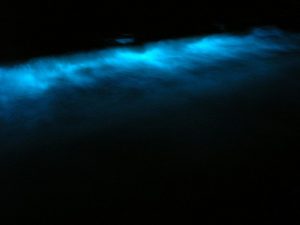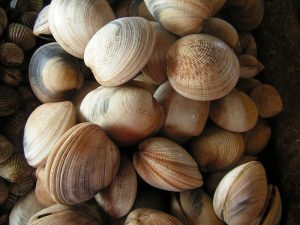Bioaccumulation of Toxins in Shellfish and the Consequences for Human Health
Toxic shellfish and toxic seafood in general are not modern phenomena. Human practices and records indicate that shellfish poisoning has been around for hundreds if not thousands of years. Many believe that diet restrictions dictated by the Bible demonstrate a wariness of shellfish poisoning. Moreover, Native Americans would keep watch for the flickering of ocean waves, an indication of dinoflagellate abundance, in order to know when to stop eating shellfish (Williams et al. 1999). Dinoflagellates are tiny marine organisms ultimately responsible for shellfish toxicity as well as the infamous red tides. More recently, the first published description in the Western World of a patient with symptoms of shellfish poisoning dates back to 1689 (Williams et al. 1999). A more famous example may be the poisoning of Captain Vancouver’s crew in British Columbia, Canada, in 1793 after they consumed toxic mussels (Landsberg 2002).
Today, doctors recognize that the ingestion of shellfish can cause several types of neurologic diseases. These diseases include shellfish poisoning, diarrheal shellfish poisoning, and neurotoxic shellfish poisoning, but paralytic shellfish poisoning is one of the most common (Williams et al. 1999). Commonly implicated varieties of shellfish include mussels, clams, oysters, and scallops. Paralytic shellfish poisoning is caused by saxitoxin found in certain shellfish (Williams et al. 1999). Because saxitoxin is heat stable, steaming and cooking do not affect its potency, so both raw and cooked shellfish can cause paralysis. Moreover, commercial processing does not eliminate the toxin. The onset of symptoms of paralytic shellfish poisoning is rapid, occurring within 30-60 minutes of ingestion. Victims complain of a feeling of pins and needles, numbness, vertigo, and tingling of the face, tongue, and lips. There are no antidotes for saxitoxin or paralytic shellfish poisoning; however, even patients with severe symptoms do well if quickly supported by respiratory systems (Williams et al. 1999).
Although shellfish contain the toxins that cause these neurological diseases, they do not produce them. Instead, these toxins come from toxic microalgae like dinoflagellates. They serve as food for the shellfish, which filter and concentrate them in digestive glands (Williams et al. 1999). Because shellfish filter feed, they can take up toxic cells from these microalgae directly from the water column (Landsberg 2002). Shellfish then store and accumulate toxins as they feed on microalgae, and these accumulated toxins can become harmful to consumers once ingested. Shellfish naturally ingest a variety of dinoflagellate species, so their toxin profiles vary depending on the toxicity of the dinoflagellate to which each population is exposed. Many toxic microalgae have sedimentary or resting stages as part of their life cycle, and in some cases, these stages may be more toxic than the floating planktonic ones. These stages can be up to 1000 times more toxic, so shellfish filtering sediments can be exposed to much higher levels of toxins (Landsberg 2002). Moreover, the location and concentration of toxins in various tissues varies between species. For example, scallops do not accumulate toxins in their adductor muscles, the only part usually consumed, so they are normally safe for public consumption (Landsberg 2002).
Although toxins are widely distributed among shellfish, generally long-term toxin deposition had not seemed to cause them adverse health effects. However, in recent years, researchers have begun to focus on the effect toxins have on shellfish and found that they may indeed harm or even kill shellfish (Landsberg 2002). This assertion gains credibility as several studies have shown that shellfish behaviorally avoid the consumption of toxic dinoflagellates (Landsberg 2002). Examples of this would be closing shells, reducing pumping and filtration rates, increasing mucus production, modifying burrowing behavior, and changing cardiac activity or oxygen consumption (Landsberg 2002). Therefore, the accumulation of toxins in shellfish has health consequences for both the shellfish themselves and the animals higher up on the food chain.
The most effective way of managing shellfish poisoning is prevention. For centuries, humans have recognized that toxic seafood coincides with certain seasons of the year, water temperatures, weather conditions, seabird mortality, and the color of the waves (Williams et al. 1999). These methods are not exact, so monitoring programs use more modern techniques when determining potential shellfish toxicity. Programs have recently used mice to monitor toxin levels in shellfish by extracting their accumulated toxins and injecting them into the mice (Williams et al. 1999). Low concentrations may have little effect while high concentrations will kill the mice. Although effective, scientists would like to find a more rapid and direct method to monitor potential shellfish toxicity that does not require the use of mice. Scholin et al. 1999 developed a method to monitor microalgae, the ultimate source for shellfish toxicity, and their concnetrations. A floating robotic instrument will take in seawater and break apart any floating cells. It will then recognize certain microalgae by the presence of their DNA and relay this information to monitoring stations onshore. This system is still not completely ready, but it promises a much faster reaction time to fluctuating levels of microalgae.

The MBARI-designed robotic instrument called the Environmental Sample Processor. Image source: NOAA.gov
Modern coastal monitoring agencies have decreased incidence of shellfish poisoning by restricting shellfish harvesting during high-risk periods, such as the period from late spring to early fall (Williams et al. 1999). Recent outbreaks of shellfish poisoning have occurred on isolated islands where public health monitoring is infrequent (Williams et al. 1999). Accumulated toxins cause illness in people, but only with elevated levels during certain periods of time. With vigilant surveillance, consumption of shellfish does not pose a significant health risk to humans.
References:
Clark, RF, SR Williams, SP Nordt, AS Manoguerra. (1999) A review of selected seafood poisonings. Undersea & hyperbaric medicine 26:3, 175–184.
Landsberg, Jan H. (2002) The Effects of Harmful Algal Blooms on Aquatic Organisms, Reviews in Fisheries Science 10:2, 113-390, doi: 10.1080/20026491051695
Scholin, C. A., R. Marin III, P. E. Miller, G. J. Doucette, C. L. Powell, P. Haydock, J. How- ard and J. Ray. (1999) DNA probes and a receptor binding assay for detection of Pseudo-nitzschia (Bacillariophyceae) species and domoic acid activity in cultured and natural samples. Journal of Phycology 35:1356–1367


